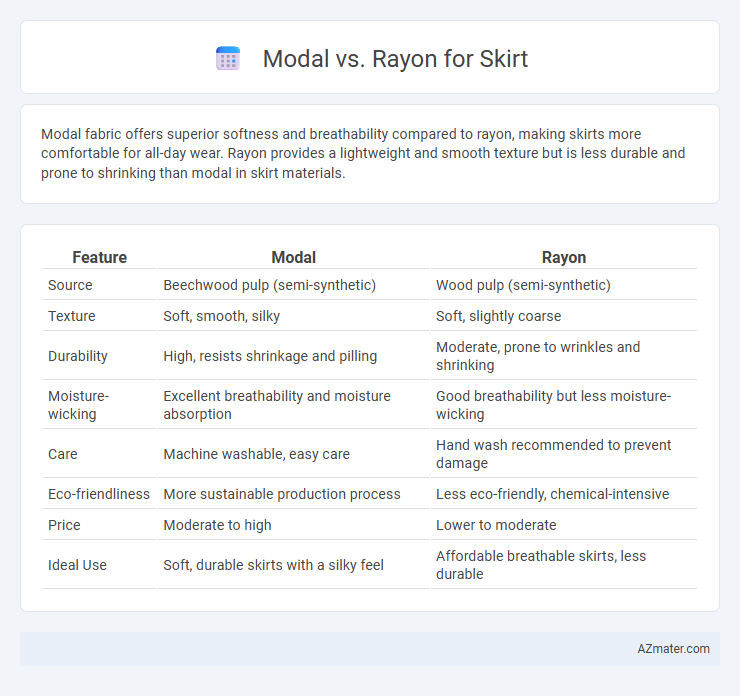Modal fabric offers superior softness and breathability compared to rayon, making skirts more comfortable for all-day wear. Rayon provides a lightweight and smooth texture but is less durable and prone to shrinking than modal in skirt materials.
Table of Comparison
| Feature | Modal | Rayon |
|---|---|---|
| Source | Beechwood pulp (semi-synthetic) | Wood pulp (semi-synthetic) |
| Texture | Soft, smooth, silky | Soft, slightly coarse |
| Durability | High, resists shrinkage and pilling | Moderate, prone to wrinkles and shrinking |
| Moisture-wicking | Excellent breathability and moisture absorption | Good breathability but less moisture-wicking |
| Care | Machine washable, easy care | Hand wash recommended to prevent damage |
| Eco-friendliness | More sustainable production process | Less eco-friendly, chemical-intensive |
| Price | Moderate to high | Lower to moderate |
| Ideal Use | Soft, durable skirts with a silky feel | Affordable breathable skirts, less durable |
Introduction to Modal and Rayon Fabrics
Modal fabric, made from beech tree cellulose, is a type of semi-synthetic rayon known for its exceptional softness, breathability, and moisture-wicking properties, making it highly suitable for skirts that require both comfort and durability. Rayon, a semi-synthetic fiber derived from wood pulp, offers versatility in texture and drape, providing a lightweight and smooth feel that enhances skirt designs with fluidity and elegance. Both Modal and rayon fabrics are biodegradable and favored for their natural fibers combined with easy-care characteristics, optimizing skirt wearability and style.
What is Modal?
Modal is a semi-synthetic fabric made from beech tree pulp, known for its softness, breathability, and moisture-wicking properties, making it a popular choice for skirts that offer comfort and durability. Compared to rayon, modal has a smoother texture, higher resistance to shrinkage, and better color retention, resulting in garments that maintain their appearance after repeated washes. Its eco-friendly production process also appeals to environmentally-conscious consumers seeking sustainable fashion options.
What is Rayon?
Rayon is a semi-synthetic fiber made from regenerated cellulose derived from wood pulp, providing a soft and breathable fabric ideal for skirts. It mimics the feel of natural fibers like cotton and silk while offering excellent drape and vibrant color retention. Unlike modal, rayon tends to be less durable and more prone to wrinkling, making fabric care an important consideration.
Key Differences Between Modal and Rayon
Modal fabric, made from beech tree pulp, offers superior softness and breathability compared to rayon, which is derived from wood pulp but often involves a more chemically intensive process. Modal is more durable and resistant to shrinkage and pilling, making skirts made from it longer-lasting and easier to maintain. Rayon skirts tend to feel heavier and less smooth, with lower moisture-wicking properties, impacting comfort in warmer climates.
Comfort and Wearability: Modal vs Rayon Skirts
Modal skirts offer superior comfort and breathability compared to rayon skirts due to their natural beechwood fiber composition, which provides a softer feel and better moisture-wicking properties. Rayon, while smooth and lightweight, tends to be less durable and can lose shape after multiple washes, affecting long-term wearability. Modal skirts maintain their softness and drape well over time, making them a preferable choice for comfortable, everyday wear.
Durability and Care Requirements
Modal fabric offers superior durability compared to rayon, maintaining its shape and color even after multiple washes due to its strong, resilient fibers made from beech tree pulp. Rayon tends to be less durable, prone to shrinking and weakening when exposed to water and improper washing techniques, requiring delicate handling and often dry cleaning. Both fabrics benefit from gentle care, but modal's resistance to pilling and fading makes it a more practical choice for long-lasting skirts.
Sustainability and Environmental Impact
Modal fabric, derived from sustainably harvested beech trees, offers a more eco-friendly alternative to Rayon, which is chemically intensive and often sourced from less sustainable wood pulp. Modal production uses less water and energy, generating fewer harmful emissions compared to Rayon's traditional viscose processes, reducing overall environmental footprint. Skirts made from Modal support sustainable fashion by combining biodegradability with enhanced durability, promoting longer garment life cycles and lower textile waste.
Price Comparison: Modal vs Rayon Skirts
Modal skirts typically cost more than rayon skirts due to their higher durability and eco-friendly production process. Rayon skirts are generally more affordable, appealing to budget-conscious shoppers looking for a versatile fabric. The price difference reflects Modal's softness and longevity compared to rayon's lightweight and cost-effective properties.
Style and Design Versatility
Modal fabric offers a smooth, luxurious feel with excellent drape, making it ideal for skirts that require fluid movement and elegant silhouettes. Rayon provides versatile design options due to its ability to mimic various textures, allowing for both structured and flowy skirt styles. The adaptability of rayon enhances creativity in patterns and fits, while modal excels in delivering consistent softness and sheen for sophisticated, stylish skirts.
Which Fabric is Best for Your Skirt?
Modal fabric offers superior softness, breathability, and moisture-wicking properties, making it ideal for skirts that prioritize comfort and a smooth drape. Rayon provides a lightweight feel with excellent breathability but tends to wrinkle more easily and may require extra care to maintain its appearance. Choosing between Modal and Rayon depends on your preference for durability and comfort, with Modal generally being best for everyday wear skirts and Rayon suited for lightweight, flowy styles.

Infographic: Modal vs Rayon for Skirt
 azmater.com
azmater.com